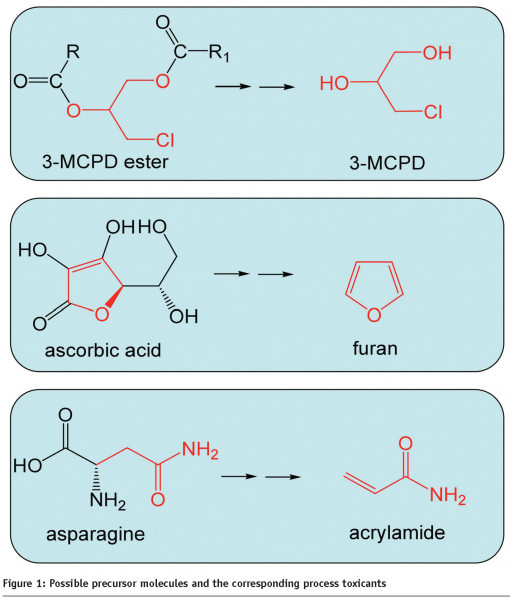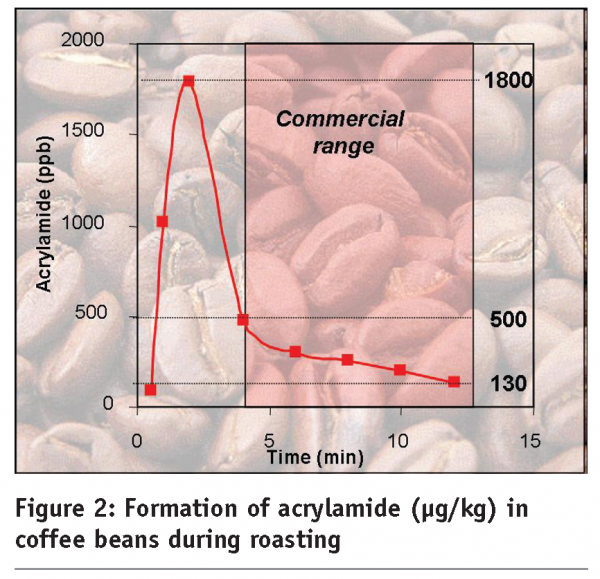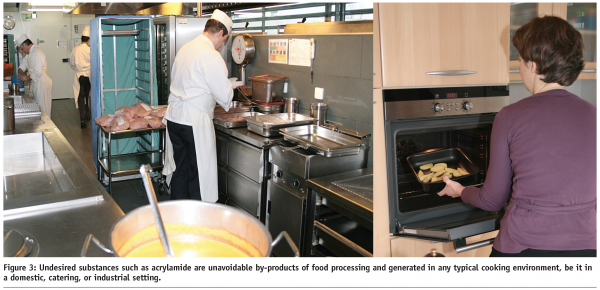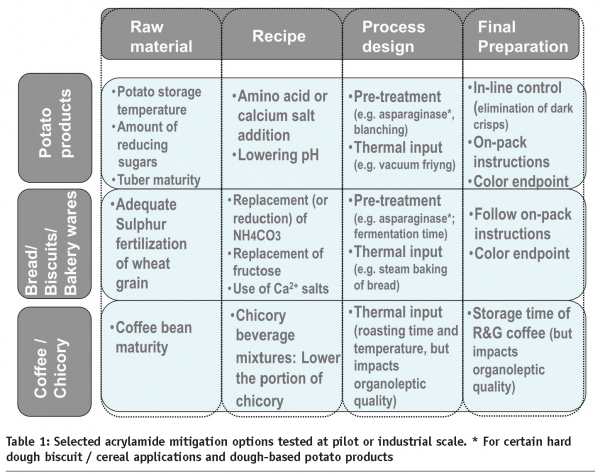Food processing contaminants: knowledge is key
- Like
- Digg
- Del
- Tumblr
- VKontakte
- Buffer
- Love This
- Odnoklassniki
- Meneame
- Blogger
- Amazon
- Yahoo Mail
- Gmail
- AOL
- Newsvine
- HackerNews
- Evernote
- MySpace
- Mail.ru
- Viadeo
- Line
- Comments
- Yummly
- SMS
- Viber
- Telegram
- Subscribe
- Skype
- Facebook Messenger
- Kakao
- LiveJournal
- Yammer
- Edgar
- Fintel
- Mix
- Instapaper
- Copy Link
Posted: 13 June 2008 | Richard H. Stadler and Viviane Theurillat, Nestlé Product Technology Centre, Switzerland | No comments yet
Food processing can be considered as a set of practices – using defined technologies and techniques, either individually or in combination, to transform raw foods / food ingredients into food ready for consumption. Some basic techniques of food processing are for example drying, curing, smoking, fermentation, canning, pasteurisation (by heat or irradiation), freezing/lyophilization and aseptic filling. Many of these processes are practiced in a domestic environment, i.e. in our everyday preparation of food in the home, or by the food manufacturing industry with the goal towards the production of foods that are nutritional, safe, tasty, and of consistently high quality.
Food processing can be considered as a set of practices – using defined technologies and techniques, either individually or in combination, to transform raw foods / food ingredients into food ready for consumption. Some basic techniques of food processing are for example drying, curing, smoking, fermentation, canning, pasteurisation (by heat or irradiation), freezing/lyophilization and aseptic filling. Many of these processes are practiced in a domestic environment, i.e. in our everyday preparation of food in the home, or by the food manufacturing industry with the goal towards the production of foods that are nutritional, safe, tasty, and of consistently high quality.
Food processing can be considered as a set of practices – using defined technologies and techniques, either individually or in combination, to transform raw foods / food ingredients into food ready for consumption. Some basic techniques of food processing are for example drying, curing, smoking, fermentation, canning, pasteurisation (by heat or irradiation), freezing/lyophilization and aseptic filling. Many of these processes are practiced in a domestic environment, i.e. in our everyday preparation of food in the home, or by the food manufacturing industry with the goal towards the production of foods that are nutritional, safe, tasty, and of consistently high quality.
Food preparation/processing is frequently related to heat-treatment which plays an important role in the formation of desirable flavours, colours, aromas and textures. In fact, exposure of food to heat can be considered as the most used processing step in modern society, involving for example frying, baking, grilling, toasting, roasting, microwaving, and broiling.
The chemical reactions that result from food processing are usually complex, leading to the formation of a plethora of new compounds, many with favourable properties. Furthermore, compounds with adverse physiological effects or potential health risks are often formed. The detection, identification and measurement of such compounds continues to increase as more sensitive analytical methodologies become available and are applied to foods. Substances that have recently raised concern as undesired by-products of thermal treatment are acrylamide, furan, and 3-monochloropropane 1,2-diol (3-MCPD). This report briefly summarises the current status of knowledge of these contaminants and highlights the gaps in the research as well as constraints faced by food manufacturers in devising appropriate mitigation strategies in the pertinent product categories.
Acrylamide in food: what we have learned so far
Acrylamide hit the news in April 2002 when Swedish researchers presented preliminary findings of its occurrence in fried and baked foods, notably in the µg/kg to low mg/kg range. This announcement raised concern as acrylamide is an industrial chemical with well known neurotoxic properties and is classified as a “probable human carcinogen”. Further research confirmed its widespread occurrence in many different foods that are consumed daily, including dietary staples such as potatoes, cereals and their products (e.g. French fries, potato crisps, bread, crisp bread, bakery wares) and coffee.
The potential risk associated with acrylamide in food was assessed by Regional and National health authorities on a global scale. The Joint FAO/WHO Expert Committee on Food Additives (JECFA) confirmed that risks to human health cannot be excluded at the level of dietary exposure. Shortly after acrylamide was first reported, it was found that the Maillard reaction is the major route of formation and that free asparagine provides the backbone of the acrylamide molecule (Figure 1). Thus, acrylamide formation in heated foods is closely linked to the generation of many of the essential organoleptic characteristics of cooked foods.
Numerous academic, government and industry research groups worldwide initiated major research programmes on mitigation. The CIAA (Confederation of the Food and Drink Industries of the EU) took this challenge on board and created a Technical Expert Group in 2003 with the main goal of coordinating research and sharing research results in a non-competitive manner. A major achievement of the Expert Group is the so-called “CIAA Acrylamide Toolbox” that today represents an up-to-date summary of the most promising avenues in reducing acrylamide, in the major food categories of concern. Importantly, the Toolbox is continuously updated as the science progresses1.
The Toolbox is not a prescriptive manual. It provides potential design tools, which may mitigate acrylamide formation when applied singly or in combination as part of optimal product design, whilst maintaining key product characteristics. Responsible food operators should consider the minimisation of acrylamide in the main “compartments” defined within the Toolbox, i.e. (i) agronomic/raw material (ii) recipe design (iii) process design, and (iv) guidance for finished product preparation. Within these, several parameters are identified and, as illustrated in Table 1, can be applied to relatively lower the acrylamide concentration in the given food product. A most recent tool worthy of mention and employed commercially in certain bakery ware and cereal products is pre-treatment with the enzyme ‘asparaginase’. Some manufacturers are working closely with the enzyme producers to integrate this additional step into their existing unit operations. Another possible avenue to pursue and described within the frame of the Heatox project is the application of infrared radiation to bakery products, that provides a reduction of acrylamide whilst maintaining the sensorial properties of the food. A major challenge in terms of mitigating the formation of acrylamide is coffee. As illustrated in Figure 2, acrylamide “losses” are evident in the final stage of roasting. Consequently, dark roasted beans will contain relatively lower amounts of acrylamide than the same light roasted beans, albeit with a major impact on the sensorial properties2,3.
So far, the preferred risk management approach for acrylamide is voluntary action by the food industry. Germany has introduced a minimisation concept (“signal value”) that measures progress over time in the main food categories. However, it fails to differentiate appropriately within certain categories (e.g. breakfast cereals category), meaning that the results may be difficult to interpret or may lead to incorrect conclusions. In California, a working plan considers that a variety of cooked foods, including roasted coffee, may require carcinogen warnings. The EU is currently performing a 3-year survey on the acrylamide level in food with the aim to assess whether or not the reduction efforts made by industry have been successful. Clearly, food manufacturers are fully committed to investigating all avenues of reduction and will continue to actively share progress in acrylamide mitigation in an open and transparent manner4.
3-MCPD esters: a new concern?
3-Monochloropropane 1,2-diol (3-MCPD) was originally identified in 1981 as a processing contaminant of acid-hydrolysed vegetable proteins (HVP), which are frequently used as ingredients of savoury foods such as soups, snacks, gravy mixes and bouillon cubes. Toxicological studies carried out by JECFA have led to a recommended provisional maximum Tolerable Daily Intake of 2 μg/kg/ bodyweight/day for 3-MCPD. Thus, the European Commission has adopted a regulatory limit of 0.02 mg/kg for 3-MCPD in soy sauce and HVP. Changes in the hydrolysis process of acid-HVP, i.e. neutralisation or employment of enzymatic hydrolysis, led to a considerable reduction in the levels of 3-MCPD in commercial products over the past decade, to ensure that 3-MCPD in the products resides within acceptable levels.
3-MCPD occurs at low levels in several foods subject to thermal treatment or fermented, such as grilled cheese, fermented cheese, roasted cereals, meats (ham, salami) as well as barley during the production of malt or domestically toasted bread. The formation of 3-MCPD was also found to be dependent on the cooking process. More recent research has highlighted the importance of “bound” 3-MCPD in foods, i.e. present in the form of mono- or diesters of fatty acids and also termed chloro-esters or 3-MCPD esters. In general, where chloro-esters are present in foods, their concentration usually exceeds that of free 3-MCPD and as such could provide an additional source of 3-MCPD, through the in vivo hydrolysis of the esters by intestinal lipase and subsequent release of 3-MCPD (Figure 1)7.
The major source of 3-MCPD
esters are refined (deodorised) vegetable oils which means that chloro-esters are present in a wide variety of food products which contain fat. A recent study by Seefelder and co-workers describes an analytical method to determine the ratio of 3-MCPD-monoesters to diesters in vegetable fat mixtures. This ratio is important, as in vivo de-esterification by pancreatic lipases is favoured in positions sn-1 and sn-3 of acylglyerols and may give an indication of the contribution of foods to the bioavailability of 3-MCPD6.
Preliminary data suggest that 3-MCPD-esters may contribute only marginally to the overall dietary exposure to free 3-MCPD in the adult population. However, further work on the bioavailability, metabolism, and possible toxicity of chloroesters per se is warranted.
Furan: only a jarred and canned health risk?
Furan is a volatile molecule which is clear, colourless, and water insoluble. It is used as an intermediate in chemical manufacturing industries, such as in the preparation of lacquers, resins, laminates, and pharmaceuticals. The presence of furan in food is not new, it has been previously described as a flavour volatile in coffee in the 1960s and found to be present in canned foods. However, the occurrence of low amounts of furan reported recently by the US FDA in 2004, in a large variety of foods and beverages, especially in thermally processed foods including baby food, has raised concern. This is due to the fact that furan is a known rodent carcinogen and the compound is classified as “possibly carcinogenic to humans”. In fact, there is evidence to indicate that furan-induced carcinogenicity is likely to be attributable to a genotoxic mechanism8.
Fresh fruits and vegetables contain little or no furan. The foods that contribute most to furan exposure are (i) canned and jarred products that have been heat treated, and (ii) crusty and dry products such as baked and roasted foods. These broad categories encompass canned soups, pastas, and sauces (gravies), which are typically found to contain the highest concentrations of furan. Brewed coffees are also uniformly high, with concentrations up to approximately 100 μg/kg. Jarred baby foods consistently have furan concentrations of 10 – 100 μg/kg, with mixtures of meat and vegetables having the highest concentrations. Due to the volatility of furan, however, heating of these products in open containers will result in relatively lower exposures from the food as consumed.
The thermal generation of furan has been studied by several research groups using model systems. In contrast to acrylamide, this has revealed a number of different precursors such as ascorbic acid, amino acids and reducing sugars, polyunsaturated fatty acids (PUFAs), organic acids, and even carotenes. Ascorbic acid is regarded as one of the major precursors of furan (Figure 1 – see page 64), and rapidly decomposes when cooked in an aqueous state (pressure cooked or low pH), roasted, pyrolysed or exposed to gamma-irradiation.
Further developments in the understanding of the mechanism of formation for furan in foods could better direct explorations into those food types likely to contain furan at significant concentrations.
The recommendations with regards to furan given by health authorities are consistent, i.e. based on the current status of knowledge, there is no need for consumers to change their dietary habits. However, a reliable risk assessment cannot be performed due to numerous data gaps, and one priority is to refine the exposure assessment through collection of meaningful data.
Challenges and constraints
Chemical alteration of food from processing produces new molecular entities which may be associated with their own risks. A key aspect to be considered in the mitigation process of toxicants is risk-benefit trade-off. Changes made to the nutritional profile of a product may negatively impact the inherent beneficial properties of the food. For example, the removal of whole grain will, in most cases, deliver a product with relatively lower acrylamide but with consequent loss of a nutritional benefit. However, the current assessment of such measures is mainly subjective and lacking is an appropriate risk-benefit framework that allows legitimate comparisons to be made.
A further dilemma acknowledged by food safety authorities, academics in the field, and in particular food producers, is which toxicants are of greatest concern in foods from a dietary health perspective? Numerous compounds have been identified over the past years in foods that show carcinogenic, mutagenic (genotoxic) or neurotoxic properties at very high doses in animal studies. Such toxicants can be classified by chemical (structural) type or by the processing methods in which they occur, and more compounds are being added to the list, exemplified by the recent Heatox report5.
To effectively address food chemical toxicants, the pooling and co-ordination of knowledge coming from a variety of disciplines and areas of expertise is crucial (agronomy, toxicology, epidemiology, analytical chemistry, food chemistry, food technology, nutrition, consumer research), as well as committed efforts of all stakeholders.








References
- The CIAA “Acrylamide Toolbox”. Available: http://www.ciaa.eu/documents/ brochures/toolbox%20rev11%20nov%202007final.pdf Accessed 30 March 2008.
- HEATOX Project 2007. Available: http://www.slv.se/upload/heatox/documents/Heatox_Final%20_report.pdf. Accessed 30 March 2008.
- Theurillat, V., leloup, V., Liardon, R., Heijmans, R. Bussmann, P. 2007. Impact of roasting conditions on acrylamide formation in coffee. 21st ASIC Colloquium.
- Bundesamt für Verbraucherschutz und Lebensmittelsicherheit, Presseinformation, 23.01.2008 -Ergebnisse der 7. Berechung der Acrylamid-Signalwerte.
- International Food Safety Authorities Network, INFOSAN Note n°02/2005. Available: http://www.who.int/foodsafety/fs_management/No_02_Acrylamide_Mar05_en_rev1.pdf. Accessed 30 March 2008.
- Seefelder, W., Varga, N., Studer, A., Williamson, G., Scanlan, F. P., & Stadler, R. H., 2008, Esters of 3-Chloro-1,2-propanediol (3-MCPD): Significance of the partial fatty acid chloroesters in the formation of free MCPD. Food Addit. Contam. 25(4): 391-400.
- Zelinková, Z., Svejkovská, B., Velíšek, J., & Doležal, M., 2006, Fatty acid esters of 3-chloropropane-1,2-diol in edible oils. Food Addit. Contam. 23 (12): 1290-1298.
- US FDA in 2004. Expolatory data on furan in food. Available: http://www.cfsan.fda.gov/~dms/furandat.html. Accessed 30 March 2008.




